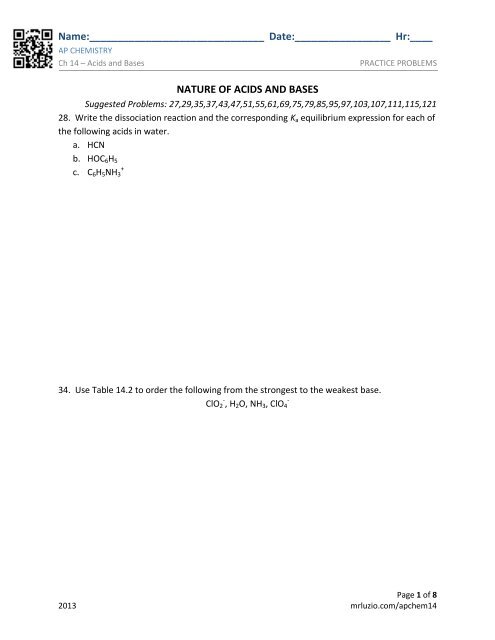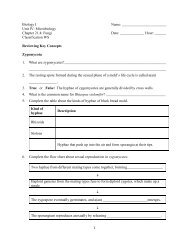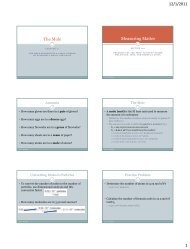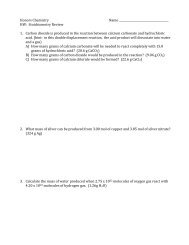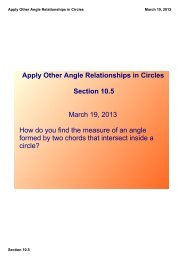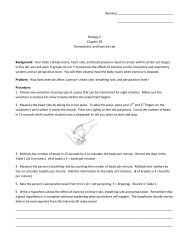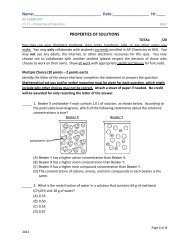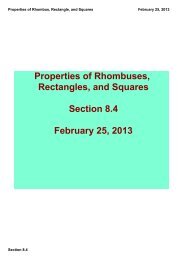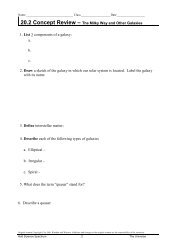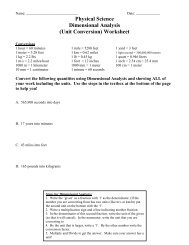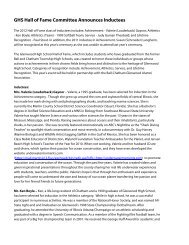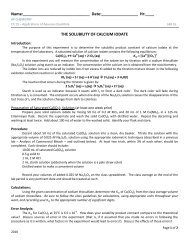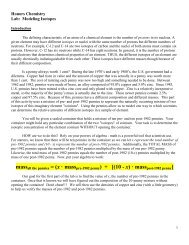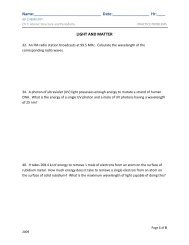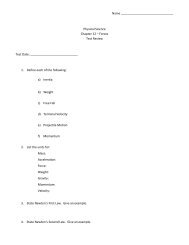Acids & Bases - AP Chemistry
Acids & Bases - AP Chemistry
Acids & Bases - AP Chemistry
You also want an ePaper? Increase the reach of your titles
YUMPU automatically turns print PDFs into web optimized ePapers that Google loves.
Name:_______________________________ Date:_________________ Hr:____<br />
<strong>AP</strong> CHEMISTRY<br />
Ch 14 – <strong>Acids</strong> and <strong>Bases</strong><br />
PRACTICE PROBLEMS<br />
NATURE OF ACIDS AND BASES<br />
Suggested Problems: 27,29,35,37,43,47,51,55,61,69,75,79,85,95,97,103,107,111,115,121<br />
28. Write the dissociation reaction and the corresponding K a equilibrium expression for each of<br />
the following acids in water.<br />
a. HCN<br />
b. HOC 6 H 5<br />
c. C 6 H 5 NH 3<br />
+<br />
34. Use Table 14.2 to order the following from the strongest to the weakest base.<br />
ClO 2 - , H 2 O, NH 3 , ClO 4<br />
-<br />
Page 1 of 8<br />
2013 mrluzio.com/apchem14
Name:_______________________________ Date:_________________ Hr:____<br />
<strong>AP</strong> CHEMISTRY<br />
Ch 14 – <strong>Acids</strong> and <strong>Bases</strong><br />
PRACTICE PROBLEMS<br />
40. At 40°C the value of K w = 2.92 x 10 -14 .<br />
a. Calculate the [H + ] and [OH - ] in pure water at 40°C.<br />
b. What is the pH of pure water at 40°C<br />
c. If the hydroxide ion concentration in a solution is 0.10 M, what is the pH at 40°C<br />
44. Fill in the missing information in the following table.<br />
pH pOH [H + ] [OH - ]<br />
Acidic, Basic,<br />
or Neutral<br />
Solution a 9.63<br />
Solution b<br />
3.9 x 10 -6 M<br />
Solution c<br />
0.027 M<br />
Solution d 12.2<br />
Page 2 of 8<br />
2013 mrluzio.com/apchem14
Name:_______________________________ Date:_________________ Hr:____<br />
<strong>AP</strong> CHEMISTRY<br />
Ch 14 – <strong>Acids</strong> and <strong>Bases</strong><br />
SOLUTIONS OF ACIDS<br />
Remember that Appendix 5.1 in your textbook contains a table of common K a values.<br />
PRACTICE PROBLEMS<br />
48. Calculate the pH of each of the following aqueous solutions.<br />
a) 0.10 M HCl<br />
b) 5.0 M HCl<br />
c) 1.0 x 10 -11 M HCl<br />
54. Calculate the pH of each of the following 0.250 M acids.<br />
a) HOC 6 H 5<br />
b) HCN<br />
Page 3 of 8<br />
2013 mrluzio.com/apchem14
Name:_______________________________ Date:_________________ Hr:____<br />
<strong>AP</strong> CHEMISTRY<br />
Ch 14 – <strong>Acids</strong> and <strong>Bases</strong><br />
PRACTICE PROBLEMS<br />
62. Calculate the pH of a solution that contains 1.0 M HF and 1.0 M HOC 6 H 5 . Also calculate the<br />
concentration of OC 6 H 5 - in this solution at equilibrium.<br />
70. One mole of a weak acid HA was dissolved in 2.0 L of solution. After the system had come<br />
to equilibrium, the concentration of HA was found to be 0.45 M. Calculate K a for HA.<br />
Page 4 of 8<br />
2013 mrluzio.com/apchem14
Name:_______________________________ Date:_________________ Hr:____<br />
<strong>AP</strong> CHEMISTRY<br />
Ch 14 – <strong>Acids</strong> and <strong>Bases</strong><br />
BASES AND POLYPROTIC ACIDS<br />
PRACTICE PROBLEMS<br />
78. Calculate [OH + ] and pH for each of the following.<br />
a) 0.00040 M Ca(OH) 2<br />
b) 25 g KOH in 1.0 L of solution<br />
84. For the reaction of hydrazine (N 2 H 4 ) in water,<br />
H 2 NNH 2 (aq) + H 2 O(l) ↔ H 2 NNH 3 + (aq) + OH - (aq) K b = 3.0 x 10 -6 .<br />
Calculate the concentrations of all species and the pH of a 2.0 M solution of hydrazine in water.<br />
Page 5 of 8<br />
2013 mrluzio.com/apchem14
Name:_______________________________ Date:_________________ Hr:____<br />
<strong>AP</strong> CHEMISTRY<br />
Ch 14 – <strong>Acids</strong> and <strong>Bases</strong><br />
PRACTICE PROBLEMS<br />
96. Arsenic acid (H 3 AsO 4 ) is a triprotic acid with K a1 = 5 x 10 -3 , K a2 = 8 x 10 -8 , and K a3 = 6 x 10 -10 .<br />
Calculate [H + ], [OH - ], [H 3 AsO 4 ], [H 2 AsO 4 - ], [HAsO 4 2- ], and [AsO 4 3- ] in a 0.20 M arsenic acid<br />
solution.<br />
Page 6 of 8<br />
2013 mrluzio.com/apchem14
Name:_______________________________ Date:_________________ Hr:____<br />
<strong>AP</strong> CHEMISTRY<br />
Ch 14 – <strong>Acids</strong> and <strong>Bases</strong><br />
ACID-BASE PROPERTIES OF SALTS<br />
PRACTICE PROBLEMS<br />
100. Arrange the following 0.10 M solutions in order from most acidic to most basic. See<br />
Appendix 5 for K a and K b values.<br />
CaBr 2 , KNO 2 , HClO 4 , HNO 2 , HONH 3 ClO 4<br />
104. Calculate the pH and the concentrations of all species present in a 0.25 M solution of<br />
ethylammonium chloride (C 2 H 5 NH 3 Cl).<br />
Page 7 of 8<br />
2013 mrluzio.com/apchem14
Name:_______________________________ Date:_________________ Hr:____<br />
<strong>AP</strong> CHEMISTRY<br />
Ch 14 – <strong>Acids</strong> and <strong>Bases</strong><br />
PRACTICE PROBLEMS<br />
108. Consider a solution of an unknown salt having the general formula BHCl, where B is one of<br />
the weak bases in Table 14.3. A 0.10 M solution of the unknown salt has a pH of 5.82. What is<br />
the actual formula of the salt<br />
112. Are solutions of the following salts acidic, basic, or neutral The relevant K a and K b values<br />
are found in Tables 14.2 and 14.3.<br />
a. KCl<br />
b. NH 4 C 2 H 3 O 2<br />
c. CH 3 NH 3 Cl<br />
d. KF<br />
e. NH 4 F<br />
f. CH 3 NH 3 CN<br />
Page 8 of 8<br />
2013 mrluzio.com/apchem14


